中国食品安全问题英语
食品安全英语作文翻译
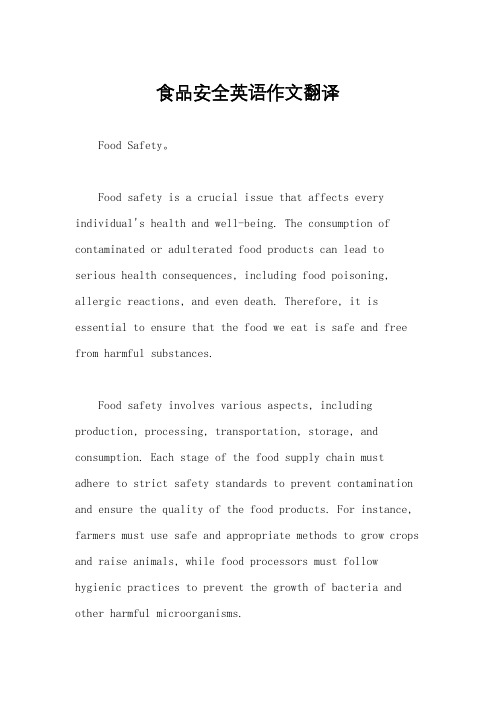
食品安全英语作文翻译Food Safety。
Food safety is a crucial issue that affects every individual's health and well-being. The consumption of contaminated or adulterated food products can lead to serious health consequences, including food poisoning, allergic reactions, and even death. Therefore, it is essential to ensure that the food we eat is safe and free from harmful substances.Food safety involves various aspects, including production, processing, transportation, storage, and consumption. Each stage of the food supply chain must adhere to strict safety standards to prevent contamination and ensure the quality of the food products. For instance, farmers must use safe and appropriate methods to grow crops and raise animals, while food processors must follow hygienic practices to prevent the growth of bacteria and other harmful microorganisms.In recent years, there have been several high-profile cases of food safety issues, such as the melamine scandalin China, where milk powder was contaminated with the toxic chemical, resulting in the deaths of several infants. Such incidents have highlighted the need for stricterregulations and better enforcement of food safety standards.To ensure food safety, governments and regulatorybodies around the world have implemented various measures, including food safety laws and regulations, food inspections, and food labeling requirements. Consumers also play a crucial role in ensuring food safety by beingvigilant about the food products they purchase and consume. They should check for expiry dates, inspect packaging for signs of damage or tampering, and avoid buying foodproducts from untrustworthy sources.In conclusion, food safety is a critical issue that requires the collective efforts of all stakeholders, including governments, regulatory bodies, food producers, processors, and consumers. By working together, we canensure that the food we eat is safe, healthy, and free from harmful substances.。
食品安全试题英语及答案
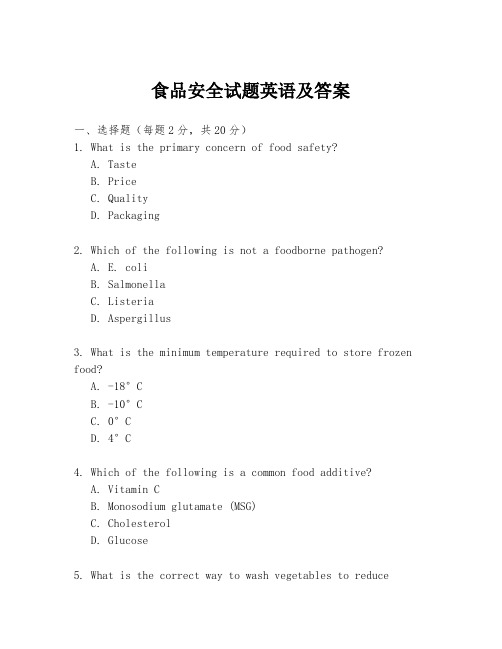
食品安全试题英语及答案一、选择题(每题2分,共20分)1. What is the primary concern of food safety?A. TasteB. PriceC. QualityD. Packaging2. Which of the following is not a foodborne pathogen?A. E. coliB. SalmonellaC. ListeriaD. Aspergillus3. What is the minimum temperature required to store frozen food?A. -18°CB. -10°CC. 0°CD. 4°C4. Which of the following is a common food additive?A. Vitamin CB. Monosodium glutamate (MSG)C. CholesterolD. Glucose5. What is the correct way to wash vegetables to reducepesticide residues?A. Soak in clean waterB. Rinse with running waterC. Use detergentD. Boil in water6. What is the main purpose of food labeling?A. To increase product appealB. To provide information about the productC. To promote salesD. To reduce costs7. Which of the following is not a food allergen?A. PeanutsB. ShellfishC. GlutenD. Salt8. What is the recommended method for cooking eggs to avoid the risk of Salmonella?A. Soft-boiledB. Sunny-side upC. ScrambledD. Fully cooked9. What is the role of preservatives in food?A. Enhance flavorB. Improve appearanceC. Extend shelf lifeD. Increase nutritional value10. What is the main reason for food spoilage?A. Contamination by microorganismsB. Exposure to sunlightC. High humidityD. Low temperature二、填空题(每空1分,共10分)11. The "use by" date on food packaging indicates the________ date up to which the product is at its best quality.12. Foodborne diseases can be prevented by practicing good________ and hygiene.13. The ________ is a common method for preserving food by removing moisture.14. Irradiation is used to sterilize food and can extend its ________.15. Organic foods are produced without the use of synthetic ________, pesticides, or other artificial chemicals.三、简答题(每题5分,共20分)16. Explain the difference between "use by" and "best before" dates on food packaging.17. Describe the importance of food traceability in ensuring food safety.18. What are the potential health risks associated with consuming contaminated seafood?19. Discuss the role of government regulations in maintaining food safety standards.四、论述题(每题15分,共30分)20. Discuss the impact of globalization on food safety and the challenges it poses.21. Analyze the role of consumer education in promoting food safety awareness.答案:一、选择题1-5: C, D, A, B, B6-10: B, D, C, C, A二、填空题11. last12. manufacturing13. dehydration14. shelf life15. fertilizers三、简答题16. "Use by" dates indicate the last day the food is safe to eat, while "best before" dates suggest the last day the food will maintain its optimal quality.17. Food traceability is crucial for tracking food products from production to consumption, allowing for rapid response in case of food safety issues and ensuring accountability throughout the supply chain.18. Consuming contaminated seafood can lead to foodborne illnesses such as gastroenteritis, and in severe cases, it can result in long-term health complications or even death.19. Government regulations play a vital role in setting and enforcing food safety standards, conducting inspections, and ensuring that food producers and handlers comply with these standards to protect public health.四、论述题20. Globalization has increased the diversity of foodavailable to consumers but has also complicated food safety due to the extended supply chains. Challenges includeensuring compliance with varying international standards and the need for greater cooperation among countries to address food safety issues.21. Consumer education is essential in promoting food safety awareness as it empowers individuals to make informed choices, understand food labels, practice safe food handling and preparation, and recognize the risks of certain food products.。
关于中国食品安全问题

染色馒头事件
食品安全大事件
染色馒头事件
过期馒头回收回来浸泡加工,然后 重新包装销售。
防腐剂、甜蜜素等添加剂,工人都是 按经验随意添加。
这个小小的镘头生产厂,每天有数以万计的问题馒头流向市场。
食品安全大事件
地沟油的职业回收者,只需一把 铲子、几个破旧铁桶、一把手电 筒,外加一辆电动车就可以满载 而归。那些暗淡浑浊、略呈红色 的膏状物,经过一夜的过滤、加 热、沉淀、分离,变身为清亮的 “食用油”,低价出售。 相关业内人士向记者透露了 更详细的餐厨废油回流餐桌的地 下链条(详见右图)。
我国食品安全现状
我国自上个世纪80年代以来,食品安全问题日益严重,
从最初曝光的二恶英、红汞、甲醛(福尔马林)、激素、面
粉添加剂(过氧化苯甲酰)、面粉漂白剂、假酒(甲醇)、 洗衣粉油条 、陈化粮毒米、苏丹红、瘦肉精、铁酱油、毛发 酱油,到牛奶业普遍使用三聚氰胺、养殖业普遍滥用抗生素、 食品工业违规滥用食品添加剂、滥用氢化油(反式脂肪酸)、
解决我国当前食品安全问题的对策
(四)充分发挥行业协会的作用 建立食品行业协会,对从业者进行职业道德和法制教育,推进诚信建设,培养自 律精神。协会要定期组织会员学习,组织会员互相检查、参观、评议,相互监督。行 业协会还应通过各种途径(国外使馆、贸易机构、媒体等)广泛收集国外,尤其是贸易 对象国和地区的行业标准、产品质量标准、检验检疫标准、环保要求,及时提供给相 关企业和政府,研究对策,帮助企业解决因“绿色壁垒”引起的贸易纠纷,维护企业 正当的权益。 (五)提高检测技术和能力,为保障食品安全提供技术支撑 无论是源头管理、市场准入、产品抽检或是进出口把关等都要有相应的检测手段。 当前,我国的食品安全问题也对质检机构的检测水平和能力提出了挑战,对质检机构 提出了更高的要求。为适应新形势下的检测工作,质检机构一方面要加强硬件建设, 不断充实新的仪器设备,配备先进的测试手段。要有一批高素质的专业检测人员,不 但精于检测工作,了解检测技术的发展趋势和动态,具有较高的理论造诣和丰富的实 际工作经验,而且还要了解当前食品的制假动态,善于从产品的外观捕捉到产品的违 禁添加物,为产品质量监督和打击假冒伪劣产品寻找到直接的突破口和切入点。
食品安全问题的英语作文
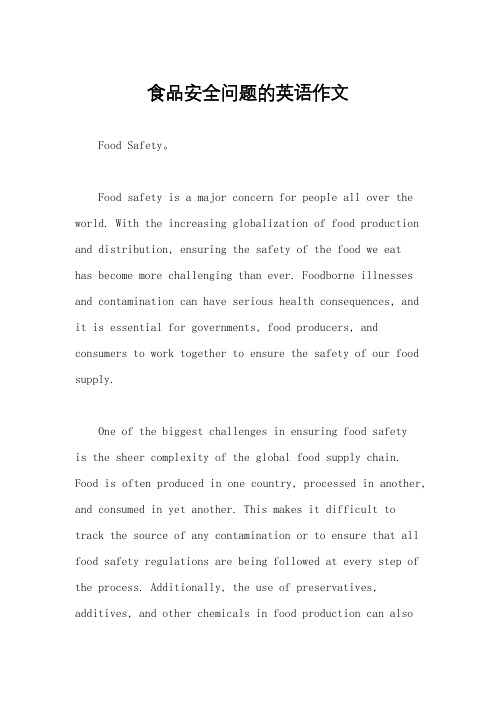
食品安全问题的英语作文Food Safety。
Food safety is a major concern for people all over the world. With the increasing globalization of food production and distribution, ensuring the safety of the food we eathas become more challenging than ever. Foodborne illnesses and contamination can have serious health consequences, and it is essential for governments, food producers, and consumers to work together to ensure the safety of our food supply.One of the biggest challenges in ensuring food safetyis the sheer complexity of the global food supply chain. Food is often produced in one country, processed in another, and consumed in yet another. This makes it difficult totrack the source of any contamination or to ensure that all food safety regulations are being followed at every step of the process. Additionally, the use of preservatives, additives, and other chemicals in food production can alsopose risks to consumers if not properly regulated.Another challenge to food safety is the rise of food allergies and intolerances. Many people have allergies or intolerances to common food ingredients such as gluten, dairy, nuts, and soy. For these individuals, consuming even small amounts of these ingredients can have serious health consequences. It is essential for food producers to clearly label their products with all ingredients and potential allergens, and for consumers to be vigilant about reading labels and asking about ingredients when dining out.In recent years, there have been several high-profile cases of foodborne illness outbreaks, which have raised public awareness about the importance of food safety. These incidents have highlighted the need for stricter regulations, better enforcement, and increased transparency in the food industry. Governments around the world have responded to these concerns by implementing new regulations and increasing inspections of food production facilities. However, it is ultimately up to food producers and consumers to ensure that these regulations are beingfollowed and that food safety is a top priority.As consumers, there are several steps we can take to protect ourselves and our families from foodborne illnesses. First and foremost, it is essential to practice good food hygiene, such as washing hands before preparing food, keeping raw and cooked foods separate, and cooking food to the appropriate temperature. Additionally, it is importantto be vigilant about food recalls and to follow any instructions from health authorities if a foodborne illness outbreak occurs. Finally, it is important to be mindful of where our food comes from and to support food producers who prioritize safety and transparency.In conclusion, food safety is a complex andmultifaceted issue that requires the cooperation of governments, food producers, and consumers to ensure the safety of our food supply. By working together, we can minimize the risk of foodborne illnesses and contamination and ensure that everyone has access to safe and nutritious food. It is essential for all of us to be informed andvigilant about food safety, and to prioritize the health and well-being of ourselves and our communities.。
近年来我国相继发生食品安全问题 英语作文
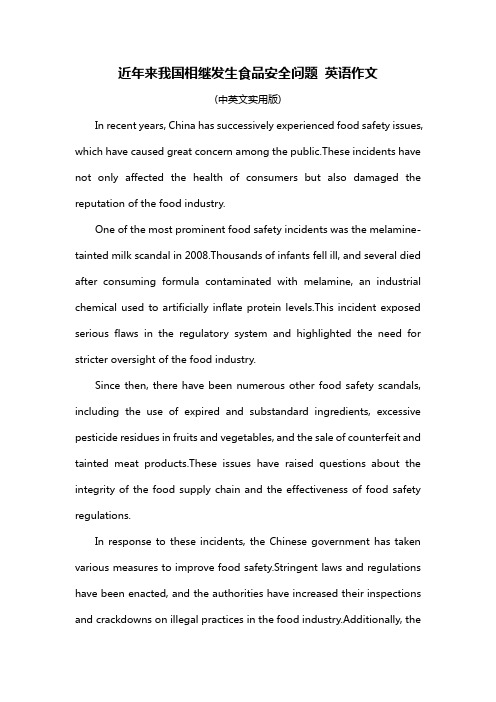
近年来我国相继发生食品安全问题英语作文(中英文实用版)In recent years, China has successively experienced food safety issues, which have caused great concern among the public.These incidents have not only affected the health of consumers but also damaged the reputation of the food industry.One of the most prominent food safety incidents was the melamine-tainted milk scandal in 2008.Thousands of infants fell ill, and several died after consuming formula contaminated with melamine, an industrial chemical used to artificially inflate protein levels.This incident exposed serious flaws in the regulatory system and highlighted the need for stricter oversight of the food industry.Since then, there have been numerous other food safety scandals, including the use of expired and substandard ingredients, excessive pesticide residues in fruits and vegetables, and the sale of counterfeit and tainted meat products.These issues have raised questions about the integrity of the food supply chain and the effectiveness of food safety regulations.In response to these incidents, the Chinese government has taken various measures to improve food safety.Stringent laws and regulations have been enacted, and the authorities have increased their inspections and crackdowns on illegal practices in the food industry.Additionally, thegovernment has been working on enhancing traceability systems to ensure that consumers can identify the origin of the food they purchase.However, despite these efforts, food safety issues still persist.The challenges faced by China"s food industry are complex and multifaceted.They include the widespread use of antibiotics in animal husbandry, the presence of heavy metals in agricultural products due to environmental pollution, and the existence of a black market for counterfeit and substandard food products.To address these challenges, it is crucial for the government to continue strengthening its regulatory framework and enforcement mechanisms.It is also essential for the food industry to embrace transparency and adopt more responsible practices.Consumers, too, play a vital role in demanding safer food and holding both the government and businesses accountable.In conclusion, the series of food safety issues that China has faced in recent years underscores the need for ongoing vigilance and improvement in the food industry.With a combination of strict regulations, strong enforcement, and increased consumer awareness, it is possible to build a safer and more trustworthy food system.中文:近年来,我国相继发生食品安全问题,引起了公众的极大关注。
食品安全问题英语作文
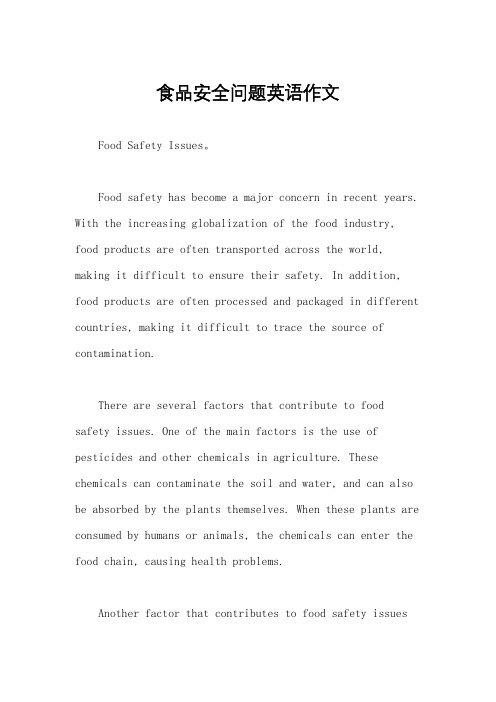
食品安全问题英语作文Food Safety Issues。
Food safety has become a major concern in recent years. With the increasing globalization of the food industry, food products are often transported across the world, making it difficult to ensure their safety. In addition, food products are often processed and packaged in different countries, making it difficult to trace the source of contamination.There are several factors that contribute to food safety issues. One of the main factors is the use of pesticides and other chemicals in agriculture. These chemicals can contaminate the soil and water, and can also be absorbed by the plants themselves. When these plants are consumed by humans or animals, the chemicals can enter the food chain, causing health problems.Another factor that contributes to food safety issuesis the use of antibiotics and hormones in animal husbandry. These chemicals are used to promote growth and prevent disease in animals, but they can also be harmful to humans when consumed in large quantities.Food processing and packaging can also contribute to food safety issues. Improper processing and packaging can lead to contamination by bacteria and other harmful microorganisms. In addition, food products that are not properly labeled or stored can also pose a risk to consumers.To address these issues, governments and international organizations have implemented a variety of measures to ensure food safety. These measures include regulations on the use of pesticides and other chemicals in agriculture, as well as regulations on the use of antibiotics and hormones in animal husbandry. In addition, food processing and packaging facilities are required to adhere to strict sanitation and safety standards.Consumers can also play a role in ensuring food safety.By reading labels and purchasing products from reputable sources, consumers can help to ensure that the food they consume is safe and healthy. In addition, consumers can take steps to properly store and prepare food to minimize the risk of contamination.In conclusion, food safety is a complex issue that requires the cooperation of governments, international organizations, and consumers. By working together, we can ensure that the food we consume is safe and healthy for ourselves and our families.。
关于食品安全英语作文OntheFoodSecurity(精选21篇)
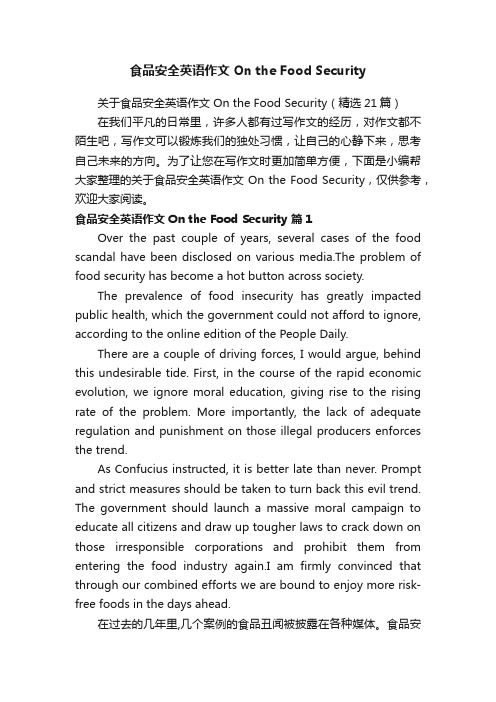
食品安全英语作文 On the Food Security关于食品安全英语作文 On the Food Security(精选21篇)在我们平凡的日常里,许多人都有过写作文的经历,对作文都不陌生吧,写作文可以锻炼我们的独处习惯,让自己的心静下来,思考自己未来的方向。
为了让您在写作文时更加简单方便,下面是小编帮大家整理的关于食品安全英语作文 On the Food Security,仅供参考,欢迎大家阅读。
食品安全英语作文 On the Food Security 篇1Over the past couple of years, several cases of the food scandal have been disclosed on various media.The problem of food security has become a hot button across society.The prevalence of food insecurity has greatly impacted public health, which the government could not afford to ignore, according to the online edition of the People Daily.There are a couple of driving forces, I would argue, behind this undesirable tide. First, in the course of the rapid economic evolution, we ignore moral education, giving rise to the rising rate of the problem. More importantly, the lack of adequate regulation and punishment on those illegal producers enforces the trend.As Confucius instructed, it is better late than never. Prompt and strict measures should be taken to turn back this evil trend. The government should launch a massive moral campaign to educate all citizens and draw up tougher laws to crack down on those irresponsible corporations and prohibit them from entering the food industry again.I am firmly convinced that through our combined efforts we are bound to enjoy more risk-free foods in the days ahead.在过去的几年里,几个案例的食品丑闻被披露在各种媒体。
中国食品安全英语演讲稿(3篇)

第1篇Ladies and gentlemen,Good morning/afternoon/evening. It is my great honor to stand before you today to discuss a topic of paramount importance: the issue of food safety in China. As we all know, food is the foundation of life, and ensuring its safety is essential for the health and well-being of our society. In this speech, I will delve into the current state of food safety in China, the challenges we face, and the steps being taken to improve the situation.I. The Current State of Food Safety in ChinaIn recent years, China has experienced a rapid economic development, which has brought about significant changes in our lives, including the food we consume. However, despite the progress, food safety remains a pressing issue in our country. Various cases of foodborne diseases and food contamination have made headlines, causing public concern and affecting consumer confidence.1. Chemical residues in agricultural productsThe excessive use of pesticides, fertilizers, and growth hormones in agriculture has led to the accumulation of chemical residues in our food. These residues can pose serious health risks, especially for childrenand pregnant women.2. Food additives and illegal ingredientsIllegal and excessive use of food additives, as well as the addition of non-food ingredients, have become common problems. These additives can cause allergies, cancer, and other health issues.3. Food processing and manufacturingThe lack of strict quality control during the food processing and manufacturing stages has also contributed to the food safety crisis. Some producers prioritize profit over safety, leading to the production of substandard products.II. Challenges in Ensuring Food Safety1. Public awarenessThe lack of awareness about food safety among the general public is a significant challenge. Many consumers are not aware of the risks associated with certain foods and do not know how to identify unsafe products.2. Inadequate regulations and enforcementAlthough China has established various laws and regulations to ensure food safety, the enforcement of these regulations remains inadequate. Some local governments and enterprises are more concerned with economic development than public health.3. Food supply chain complexityThe complexity of the food supply chain in China makes it difficult to monitor and regulate. From farm to table, there are numerous links inthe chain, and it is challenging to ensure that each link adheres tofood safety standards.III. Steps towards Improving Food Safety in China1. Strengthening public awarenessThe government and relevant organizations should launch public campaigns to raise awareness about food safety. This includes educating consumers on how to identify unsafe products and how to maintain a healthy diet.2. Improving regulations and enforcementThe government should strengthen the implementation of food safety laws and regulations, ensuring that all enterprises comply with the standards. Strict penalties should be imposed on violators to deter illegal practices.3. Enhancing the food supply chainThe government should invest in improving the infrastructure and technology of the food supply chain. This includes the establishment oftraceability systems, which can help identify the source of contaminated food and prevent further outbreaks.4. Encouraging sustainable agriculturePromoting sustainable agricultural practices, such as organic farming and the reduction of chemical inputs, can help reduce the presence of chemical residues in our food.IV. ConclusionEnsuring food safety in China is a long-term and challenging task. However, with the collective efforts of the government, enterprises, and the public, we can make significant progress in this area. By raising public awareness, improving regulations, and enhancing the food supply chain, we can create a safer and healthier food environment for all.In conclusion, food safety is not just a government responsibility but a collective effort. Let us work together to protect our health and well-being, and build a future where we can all enjoy safe and nutritious food.Thank you for your attention.第2篇Ladies and gentlemen,Good morning/afternoon/evening. It is my great honor to stand before you today to address a topic that is of paramount importance to us all –food safety. In a world where the consumption of food is an integral part of our daily lives, ensuring that the food we eat is safe and nutritious is not just a luxury but a fundamental right. Today, I will be focusing on the efforts being made in China to enhance food safety and the challenges we still face in this journey towards healthier lives.Firstly, let us acknowledge the importance of food safety. Food is the foundation of our health and well-being. It provides us with the necessary nutrients and energy to live fulfilling lives. However, when food is contaminated with harmful substances or is improperly processed,it can lead to serious health issues, including foodborne illnesses, chronic diseases, and even death. Therefore, the need for robust food safety regulations and practices is evident.China, as the world's most populous country, has a vast food supply chain that spans from production to consumption. Over the past few decades, China has made significant strides in improving food safety. However, there are still numerous challenges that need to be addressed. In this speech, I will discuss the progress made in China's food safety efforts, the existing issues, and the future prospects.I. Progress in Food Safety Efforts1. Strengthening Legal FrameworkChina has been actively working to establish a comprehensive legal framework for food safety. The Food Safety Law of the People's Republic of China, which came into effect in 2015, is a landmark legislation that sets the foundation for food safety governance. It covers the entire food chain, from production to consumption, and imposes strict penalties for violations.2. Enhancing Regulatory OversightThe Chinese government has established a multi-level regulatory system to oversee food safety. The State Administration for Market Regulation (SAMR) is responsible for the overall administration of food safety, while local governments are responsible for the enforcement of food safety regulations at the provincial, municipal, and county levels. This system ensures that food safety is monitored at every stage of the supply chain.3. Promoting Industry Self-regulationThe Chinese government encourages the food industry to adopt good manufacturing practices (GMP) and good agricultural practices (GAP) to ensure food safety. Industry associations and self-regulatory organizations have been established to promote these practices and provide guidance to food producers.4. Improving Public AwarenessEfforts have been made to raise public awareness about food safety. Educational campaigns, media coverage, and social media platforms are used to disseminate information about safe food handling, storage, and preparation. This has led to a greater understanding among consumers about the importance of food safety.II. Existing Issues1. Contamination and Illegal AdditivesDespite the progress made, China still faces challenges such as food contamination and the use of illegal additives. These issues arise from the use of substandard agricultural inputs, inadequate hygiene practices, and the presence of illegal food processing facilities.2. Food FraudFood fraud, which involves the substitution, mislabeling, oradulteration of food products, is another significant issue. This can occur at various stages of the supply chain and can pose serious health risks to consumers.3. Insufficient ResourcesThe vast scale of the Chinese food industry requires a substantial amount of resources to ensure effective food safety oversight. However, there are still areas where resources are insufficient, leading to gaps in the regulatory framework.III. Future Prospects1. Strengthening the Legal FrameworkChina needs to continue to strengthen the legal framework for foodsafety by amending existing laws and regulations and introducing new ones to address emerging issues.2. Enhancing Regulatory OversightThe government should focus on enhancing the efficiency of regulatory oversight by improving inspection and monitoring systems, as well as enforcing stricter penalties for violations.3. Promoting Industry Self-regulationIndustry self-regulation should be further promoted by encouraging food producers to adopt international standards and best practices.4. Investing in ResourcesTo address the challenges of food safety, China needs to invest in resources, including personnel, technology, and infrastructure, to ensure effective food safety oversight.In conclusion, ensuring food safety is a continuous process that requires the efforts of all stakeholders. China has made significant progress in this area, but there is still much work to be done. By strengthening the legal framework, enhancing regulatory oversight, promoting industry self-regulation, and investing in resources, China can move closer to achieving a food-safe society. This will not only protect the health of its citizens but also enhance the country's reputation as a responsible member of the global community.Thank you for your attention, and I welcome your questions and comments.第3篇Ladies and gentlemen,Good morning/afternoon/evening. It is my great honor to stand before you today to discuss a topic of paramount importance – the issue of food safety in China. As we all know, food is the cornerstone of human existence, and ensuring its safety is crucial for the well-being and health of our society. In recent years, China has made significant strides in improving its food safety standards, but there is still much work to be done. In this speech, I will delve into the current state of food safety in China, the challenges we face, and the steps being taken to safeguard our food supply.I. The Current State of Food Safety in ChinaIn the past decade, China has witnessed a rapid economic growth, which has brought along with it a more diverse and abundant food supply. However, this prosperity has also exposed the vulnerabilities in our food safety system. The following are some of the key issues we are facing:1. Contaminated food: Pesticide residues, heavy metals, and other harmful substances have been found in various food products, posing serious health risks to consumers.2. Adulterated food: Some manufacturers use substandard ingredients or add illegal additives to their products to cut costs and increase profits, compromising the quality and safety of food.3. Illegal production: There are still some unscrupulous producers who operate in the shadows, using unsafe practices and selling their products on the black market.II. Challenges in Food SafetyTo address the food safety challenges in China, we need to identify the root causes and take effective measures. The following are some of the key challenges we are facing:1. Lack of awareness: Many consumers are not fully aware of the importance of food safety and the potential risks associated with consuming contaminated or adulterated food.2. Inadequate regulations: The existing food safety regulations are not always strictly enforced, leading to gaps in the oversight and control of the food supply chain.3. Insufficient inspections: There is a shortage of inspectors and resources to monitor the vast food industry, making it difficult to ensure that all food products meet safety standards.III. Steps Being Taken to Improve Food SafetyIn response to the food safety challenges, the Chinese government and various stakeholders have been working tirelessly to improve the situation. Here are some of the measures being taken:1. Strengthening regulations: The government has introduced stricter food safety laws and regulations, imposing heavier penalties onviolators to deter illegal practices.2. Enhancing inspections: More resources are being allocated to inspect food production facilities, processing plants, and markets to ensure compliance with safety standards.3. Public awareness campaigns: Efforts are being made to educate consumers about food safety, encourage them to choose healthy and safe food products, and report any violations.4. International cooperation: China is actively participating in global food safety initiatives, learning from the experiences of other countries and sharing best practices.IV. The Role of StakeholdersImproving food safety is a collective responsibility that requires the involvement of all stakeholders, including government agencies, food producers, consumers, and the media. Here are some ways in which each stakeholder can contribute:1. Government: Enforce food safety regulations, allocate sufficient resources for inspections, and establish a transparent and efficient regulatory system.2. Food producers: Adhere to safety standards, use safe and high-quality ingredients, and provide accurate product information to consumers.3. Consumers: Be aware of food safety issues, choose safe and healthy food products, and report any suspicious activities to relevant authorities.4. Media: Provide accurate and timely information about food safety, hold producers and regulators accountable, and promote a healthy food culture.V. ConclusionIn conclusion, ensuring food safety in China is a daunting task, but it is essential for the well-being of our society. By strengthening regulations, enhancing inspections, raising public awareness, and fostering collaboration among stakeholders, we can gradually improve the food safety situation in our country. Let us all commit to working together to create a safer and healthier food environment for future generations.Thank you for your attention, and I welcome any questions or comments you may have.。
英语作文FoodSafety食品安全(精选5篇)

英语作文FoodSafety食品安全(精选5篇)第一篇:英语作文 Food Safety 食品安全Food Safety 食品安全提纲:1、食品安全事件不断发生所以近年来越来越受到关注;2、它造成巨大的危害;3、我们该如何做?危害:1、浪费资源;2、对诚信经营是打击,产生道德危机;3、严重危害群众的健康和生命。
对策:1、法律;2、识别;3、加强监管。
本写作范文由河南专升本网整理发布Nowadays, unsafe foods can be found, now and then, in the market, which has aroused a lot of public attention.It is reported that these foodstuff ranges from substandard milk powder, tainted/dyed steamed buns to pork with lean meat powder.Fake commodities are harmful in many ways.To begin with, it is a waste of resource, especially in our country.Second, it has bad effect on the reputation of the real manufacturers and brings about moral Crisis.Above all, all that matters is food.people’s health and lives are severely threatened if someone buys some unsafe foodstuff.Measures should be take to deal with the problem.On the one hand , strict laws should be passed to punish the producers and the sellers.On the other hand, consumers should be told to distinguish the genuine goods from the false ones.Atthe same time, the government should strengthen the supervision of all aspects of food.I firmly believe this problem will be solved in the near future.Global Shortage of Fresh Water 全球淡水短缺提纲:1、人们以为淡水是取之不尽的(提示:雨水、河水、井水......);2、实际上淡水是非常紧缺的(提示:人口增加,工业用水增加,污染......);3、我们应该怎么办?原因:1、人口增加;2、工业用水增加;3、污染......。
中国现有的食品安全英语
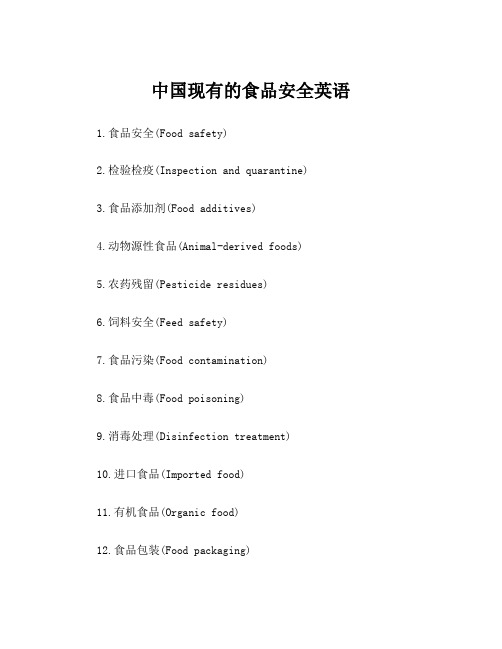
中国现有的食品安全英语1.食品安全(Food safety)2.检验检疫(Inspection and quarantine)3.食品添加剂(Food additives)4.动物源性食品(Animal-derived foods)5.农药残留(Pesticide residues)6.饲料安全(Feed safety)7.食品污染(Food contamination)8.食品中毒(Food poisoning)9.消毒处理(Disinfection treatment)10.进口食品(Imported food)11.有机食品(Organic food)12.食品包装(Food packaging)13.食品流通(Food distribution)14.无公害农产品(Pollution-free agricultural products)15.食品安全法(Food Safety Law)16.食品安全标准(Food safety standards)17.食品安全监督(Food safety supervision)18.食品安全风险评估(Food safety risk assessment)19.食品安全教育(Food safety education)20.食品安全事件(Food safety incidents)21.食品安全管理体系(Food safety management system)22.食品追溯系统(Food traceability system)1. Food safety is a major concern in China.在中国,食品安全是一个重大问题。
2. The inspection and quarantine of imported food is strict.进口食品的检验检疫非常严格。
3. Some food additives are harmful to human health.某些食品添加剂对人体健康有害。
食品安全问题 Food Safety Issues-最新范文
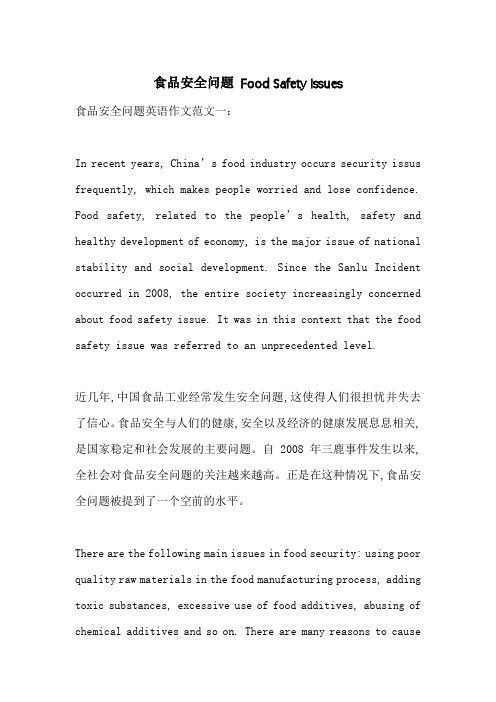
食品安全问题Food Safety Issues食品安全问题英语作文范文一:In recent years, China’s food industry occurs security issus frequently, which makes people worried and lose confidence. Food safety, related to the people’s health, safety and healthy development of economy, is the major issue of national stability and social development. Since the Sanlu Incident occurred in 2008, the entire society increasingly concerned about food safety issue. It was in this context that the food safety issue was referred to an unprecedented level.近几年,中国食品工业经常发生安全问题,这使得人们很担忧并失去了信心。
食品安全与人们的健康,安全以及经济的健康发展息息相关,是国家稳定和社会发展的主要问题。
自2008年三鹿事件发生以来,全社会对食品安全问题的关注越来越高。
正是在这种情况下,食品安全问题被提到了一个空前的水平。
There are the following main issues in food security: using poor quality raw materials in the food manufacturing process, adding toxic substances, excessive use of food additives, abusing of chemical additives and so on. There are many reasons to causethis problem, and regulators, producers and even consumers share responsibilities. The entire society should try effort to avoid food safety issues.食品安全主要存在以下问题:在生产食品过程使用劣质的原材料,添加有毒物质,过量使用防腐剂,滥用化学添加剂等等。
食品安全问题英语作文
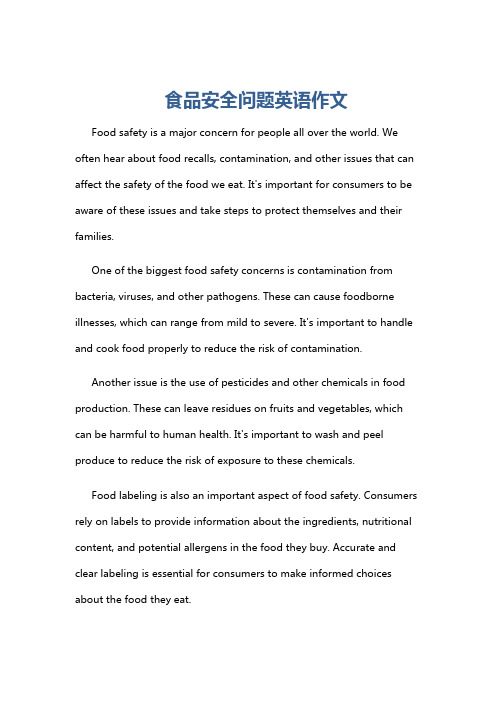
食品安全问题英语作文Food safety is a major concern for people all over the world. We often hear about food recalls, contamination, and other issues that can affect the safety of the food we eat. It's important for consumers to be aware of these issues and take steps to protect themselves and their families.One of the biggest food safety concerns is contamination from bacteria, viruses, and other pathogens. These can cause foodborne illnesses, which can range from mild to severe. It's important to handle and cook food properly to reduce the risk of contamination.Another issue is the use of pesticides and other chemicals in food production. These can leave residues on fruits and vegetables, which can be harmful to human health. It's important to wash and peel produce to reduce the risk of exposure to these chemicals.Food labeling is also an important aspect of food safety. Consumers rely on labels to provide information about the ingredients, nutritional content, and potential allergens in the food they buy. Accurate and clear labeling is essential for consumers to make informed choices about the food they eat.Cross-contamination is a common problem in home kitchens and restaurants. This occurs when bacteria from one food item are transferred to another, potentially causing illness. It's important to use separate cutting boards, utensils, and other tools to prevent cross-contamination.In conclusion, food safety is a complex issue that requires attention from both consumers and food producers. By being aware of potential risks and taking steps to reduce them, we can all work together to ensure the safety of the food we eat.。
食品安全问题英语作文
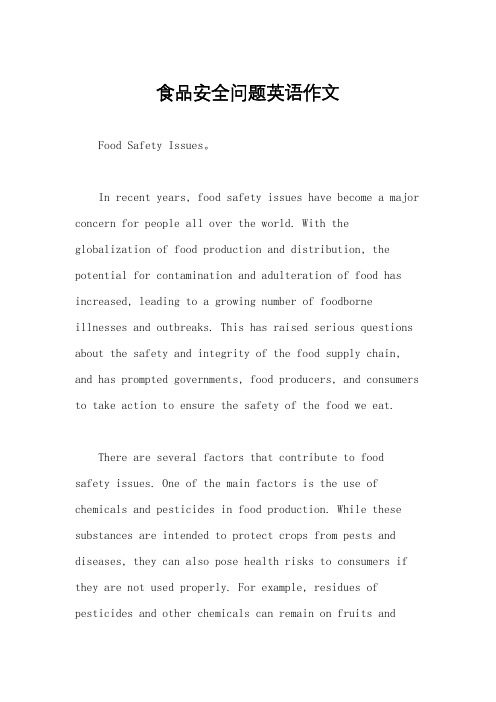
食品安全问题英语作文Food Safety Issues。
In recent years, food safety issues have become a major concern for people all over the world. With the globalization of food production and distribution, the potential for contamination and adulteration of food has increased, leading to a growing number of foodborne illnesses and outbreaks. This has raised serious questions about the safety and integrity of the food supply chain, and has prompted governments, food producers, and consumers to take action to ensure the safety of the food we eat.There are several factors that contribute to food safety issues. One of the main factors is the use of chemicals and pesticides in food production. While these substances are intended to protect crops from pests and diseases, they can also pose health risks to consumers if they are not used properly. For example, residues of pesticides and other chemicals can remain on fruits andvegetables even after they have been washed, and can accumulate in the body over time, leading to long-term health problems. In addition, the use of antibiotics and hormones in animal farming can also have negative effects on human health, as these substances can be transferred to consumers through the consumption of meat and dairy products.Another factor that contributes to food safety issues is the lack of proper hygiene and sanitation in food processing and handling. In many developing countries, food is often prepared and sold in unhygienic conditions, increasing the risk of contamination by bacteria, viruses, and other pathogens. This can result in foodborne illnesses such as diarrhea, vomiting, and fever, which can be particularly dangerous for vulnerable populations such as children, the elderly, and people with weakened immune systems.Furthermore, the globalization of the food supply chain has made it more difficult to track and trace the source of foodborne illnesses and outbreaks. With food being producedand distributed across different countries and regions, it can be challenging to identify the origin of contaminated food and to take appropriate measures to prevent further spread of the illness. This has led to a growing need for international cooperation and coordination in food safety management, to ensure that all stakeholders work together to address the root causes of food safety issues and to prevent future outbreaks.To address these food safety issues, governments and food producers need to take proactive measures to ensure the safety and integrity of the food supply chain. This includes implementing strict regulations and standards for the use of chemicals and pesticides in food production, as well as promoting sustainable and organic farming practices that minimize the use of harmful substances. In addition, food processing and handling facilities need to adhere to strict hygiene and sanitation standards, to minimize the risk of contamination and to ensure the safety of the food they produce.Consumers also play a crucial role in ensuring foodsafety. By being informed and vigilant about the food they consume, consumers can make informed choices about the food they buy and eat, and can demand transparency and accountability from food producers and retailers. This includes asking questions about the origin and production methods of the food they buy, and reporting any concerns or suspicions about the safety of the food they consume.In conclusion, food safety issues are a growing concern for people all over the world, and require a concerted effort from governments, food producers, and consumers to address. By taking proactive measures to ensure the safety and integrity of the food supply chain, and by promoting transparency and accountability in food production and distribution, we can work together to ensure that the food we eat is safe and healthy for everyone.。
英语食品安全问题演讲稿(3篇)

第1篇Good morning/afternoon/evening. It is my great honor to stand before you today to discuss a critical issue that affects all of us – food safety. Food safety is a fundamental aspect of public health, and it isessential for the well-being of individuals, families, and communities. Unfortunately, in recent years, we have witnessed numerous cases of foodborne illnesses and food safety scandals, which have raised serious concerns about the quality and safety of our food supply. In this speech, I will address the causes and consequences of food safety issues, and propose some solutions to ensure a safer food supply for everyone.I. Causes of Food Safety Issues1. Poor hygiene practicesOne of the primary causes of food safety issues is poor hygienepractices in food production and handling. This includes improper hand washing, lack of sanitation in food preparation areas, and failure to maintain clean equipment and utensils. These practices can lead to the contamination of food with harmful bacteria, viruses, and parasites.2. Unsafe agricultural practicesAnother significant cause of food safety issues is unsafe agricultural practices. This includes the use of excessive amounts of pesticides, antibiotics, and hormones in livestock and crops. These substances can accumulate in the food chain, posing health risks to consumers.3. Lack of regulation and enforcementIn some cases, food safety issues arise due to a lack of regulation and enforcement. This can lead to the production and distribution of unsafe food products, as manufacturers and retailers may cut corners to reduce costs and increase profits.4. Globalization of the food supply chainThe globalization of the food supply chain has also contributed to food safety issues. As food products are transported across borders, there isan increased risk of contamination and spoilage. Additionally, it becomes more challenging to trace the origin of food products, making it difficult to identify the source of a foodborne illness outbreak.II. Consequences of Food Safety Issues1. Health risksThe most immediate consequence of food safety issues is the risk of foodborne illnesses. These illnesses can range from mild to severe, and in some cases, they can be life-threatening. Foodborne illnesses can lead to symptoms such as nausea, vomiting, diarrhea, and abdominal pain, and they can also cause chronic health problems, such as kidney damage and neurological disorders.2. Economic lossesFood safety issues can also result in significant economic losses. This includes the cost of medical treatment for those affected by foodborne illnesses, the cost of recalls and product withdrawals, and the loss of consumer confidence in the food industry.3. Social and psychological impactsFood safety issues can have profound social and psychological impacts on individuals and communities. The fear of foodborne illnesses can lead to anxiety and stress, and it can also cause a loss of trust in food producers and retailers.III. Solutions to Ensure Food Safety1. Strengthening regulation and enforcementTo address food safety issues, governments and regulatory agencies must strengthen regulation and enforcement. This includes implementing strict standards for food production, processing, and distribution, and ensuring that these standards are enforced consistently.2. Improving hygiene practicesFood producers and handlers must adhere to proper hygiene practices to minimize the risk of contamination. This includes training employees on food safety, maintaining clean food preparation areas, and using proper sanitation techniques.3. Promoting sustainable agricultural practicesGovernments and agricultural organizations must promote sustainable agricultural practices that minimize the use of harmful substances and reduce the risk of contamination in the food supply chain.4. Enhancing traceabilityTo identify the source of foodborne illness outbreaks, it is crucial to enhance traceability in the food supply chain. This can be achieved through the use of technology, such as barcoding and RFID tags, to track the movement of food products from farm to table.5. Raising consumer awarenessFinally, raising consumer awareness about food safety is essential. Consumers should be educated on how to select and prepare safe food, and they should be encouraged to report any food safety concerns to the appropriate authorities.In conclusion, food safety is a critical issue that requires the attention and cooperation of governments, regulatory agencies, food producers, and consumers. By addressing the causes of food safety issues and implementing effective solutions, we can ensure a safer food supply for everyone. Thank you for your attention.第2篇Good morning/afternoon/evening. Today, I stand before you to discuss a crucial issue that affects us all – food safety. As we rely on food for our survival and well-being, it is imperative that we address the challenges posed by food safety issues. In this speech, I will highlight the significance of food safety, the prevalent problems, and the measures that can be taken to ensure a safer food supply.I. The Significance of Food SafetyFood safety is a global concern that affects billions of people worldwide. It is essential for several reasons:1. Health and Well-being: Food safety ensures that the food we consume is free from harmful bacteria, viruses, and contaminants. This prevents foodborne illnesses, which can lead to severe health complications and even death.2. Economic Impact: Food safety issues can have a significant economic impact on individuals, businesses, and governments. The costs associated with foodborne illnesses, including medical expenses, lost productivity, and legal claims, can be enormous.3. Social Responsibility: As responsible consumers and citizens, it is our duty to prioritize food safety. By ensuring the safety of the food we consume, we contribute to the well-being of our communities and protect the vulnerable populations, such as children, the elderly, and individuals with weakened immune systems.II. Prevalent Food Safety ProblemsDespite the importance of food safety, several issues persist, posing risks to public health:1. Contaminated Food: Food contamination occurs when harmful bacteria, viruses, parasites, or chemicals enter the food supply. Common sources of contamination include poor hygiene practices, contaminated water, and improper storage and handling of food.2. Adulteration: Food adulteration involves adding harmful substances, such as fillers, preservatives, or contaminants, to food products to increase their weight, volume, or shelf life. This practice can lead to health risks and deception of consumers.3. Mislabeling: Mislabeling occurs when food products are inaccurately labeled, leading to misinformed consumers. This can include false claims about the origin, nutritional value, or ingredients of the product.4. Lack of Regulation: In some regions, inadequate regulations and enforcement mechanisms hinder the implementation of food safety standards, allowing unsafe practices to persist.III. Measures to Ensure Food SafetyTo address these challenges, several measures can be taken at various levels:1. Governmental Regulation: Governments should establish and enforce stringent food safety regulations to ensure compliance withinternational standards. This includes regular inspections, testing, and penalties for non-compliance.2. Industry Responsibility: Food producers, processors, and retailers must prioritize food safety by implementing robust safety management systems, maintaining hygiene standards, and ensuring the quality oftheir products.3. Consumer Awareness: Educating consumers about food safety practices, such as proper food handling, storage, and preparation, can help prevent foodborne illnesses. Additionally, consumers should be vigilant about the quality and labeling of food products.4. International Collaboration: Collaboration between governments, international organizations, and industry stakeholders is crucial to share best practices, develop global standards, and address cross-border food safety issues.5. Technological Advancements: Embracing technology, such as blockchain and traceability systems, can enhance the monitoring and management of the food supply chain, making it easier to identify and recall contaminated products.In conclusion, food safety is a vital concern that demands our attention and collective efforts. By addressing the prevalent problems and implementing effective measures, we can ensure a safer food supply for present and future generations. Let us all play our part in creating a food-safe world.Thank you.第3篇Ladies and Gentlemen,Good morning/afternoon/evening. It is my great honor to stand before you today to address a topic of paramount importance – food safety. In an era where the global food supply chain is more interconnected than ever before, the issue of food safety has become a matter of urgency that transcends borders and affects every single one of us.As we all know, food is the foundation of life. It provides us with the necessary nutrients and energy to thrive and lead fulfilling lives. However, the very same food that sustains us can also pose a significant risk to our health and well-being if not handled and processed with the utmost care. Today, I will discuss the current state of food safety, its implications, and the steps we can take to ensure a safer food supplyfor all.The Current State of Food SafetyOver the past few decades, the food industry has undergone significant transformations. Advances in technology, globalization, and the demand for convenience have all contributed to the rapid expansion of the food market. While these developments have brought numerous benefits, they have also introduced new challenges, particularly in terms of food safety.1. Contaminated Food Products: Foodborne illnesses, such as E. coli, Salmonella, and Listeria, are a persistent threat. These pathogens can contaminate food at various stages, from production to processing, distribution, and consumption.2. Chemical Residues: Pesticides, herbicides, and antibiotics are commonly used in agricultural practices. While these substances are intended to enhance crop yields and protect animals from diseases, their residues can accumulate in the food chain and pose health risks to consumers.3. Food Fraud: Adulteration and mislabeling of food products are widespread. This not only defrauds consumers but also poses serious health risks, as some adulterants may be harmful to human health.4. Climate Change: The changing climate is impacting agricultural practices and food production. Extreme weather events, such as floods and droughts, can lead to crop failures and food shortages, increasing the risk of foodborne diseases.Implications of Food Safety IssuesThe consequences of food safety issues are far-reaching. They include:1. Public Health Risks: Foodborne illnesses can lead to severe health problems, including hospitalization and death. The global burden of foodborne diseases is substantial, with an estimated 550 million people falling ill and 420,000 dying annually.2. Economic Losses: Food safety incidents can cause significant economic losses for both consumers and producers. Recalls, product withdrawals, and legal actions can lead to substantial financial consequences.3. Reputational Damage: Food safety issues can tarnish the reputation of food producers, retailers, and entire industries, leading to loss of consumer trust and confidence.Steps to Ensure Food SafetyTo address the challenges posed by food safety, it is essential to take a multi-faceted approach:1. Strengthen Regulatory Frameworks: Governments should establish and enforce strict food safety regulations to ensure that food producers adhere to best practices.2. Enhance Food Traceability: Implementing a robust food traceability system will help in identifying the source of contamination and preventing the spread of harmful pathogens.3. Promote Sustainable Agricultural Practices: Encourage the use of organic farming methods and promote sustainable agricultural practices to reduce the use of harmful chemicals and protect the environment.4. Educate Consumers: Raise awareness about food safety among consumers by providing information on safe food handling, storage, and preparation.5. Invest in Research and Development: Support research initiatives aimed at developing innovative solutions to food safety challenges, such as genetically modified organisms (GMOs) and alternative farming methods.6. Global Collaboration: Foster international cooperation to share knowledge, resources, and best practices in food safety.In conclusion, food safety is a complex issue that requires a concerted effort from all stakeholders. By strengthening regulatory frameworks, enhancing food traceability, promoting sustainable agricultural practices, educating consumers, investing in research, and fostering global collaboration, we can ensure a safer food supply for future generations.Thank you for your attention, and I urge each and every one of us to take responsibility for our own food safety and contribute to a healthier, safer world.Thank you.。
中国食品安全英语作文
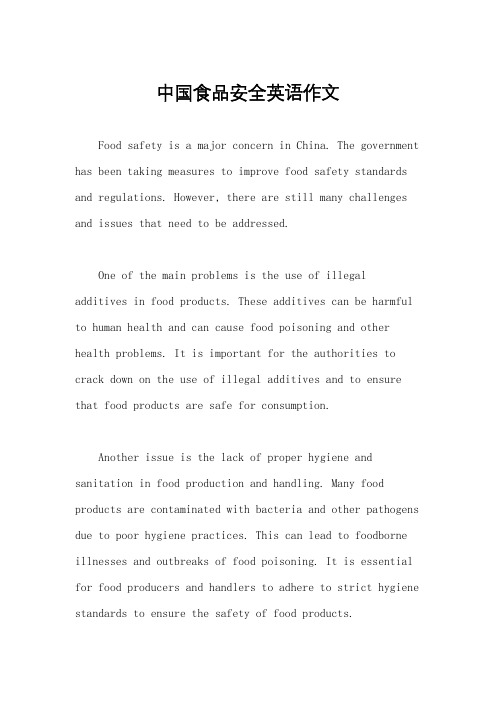
中国食品安全英语作文Food safety is a major concern in China. The government has been taking measures to improve food safety standards and regulations. However, there are still many challenges and issues that need to be addressed.One of the main problems is the use of illegaladditives in food products. These additives can be harmful to human health and can cause food poisoning and other health problems. It is important for the authorities to crack down on the use of illegal additives and to ensure that food products are safe for consumption.Another issue is the lack of proper hygiene and sanitation in food production and handling. Many food products are contaminated with bacteria and other pathogens due to poor hygiene practices. This can lead to foodborne illnesses and outbreaks of food poisoning. It is essential for food producers and handlers to adhere to strict hygiene standards to ensure the safety of food products.In addition, there is a lack of transparency and accountability in the food industry. Some food producers and manufacturers may engage in fraudulent practices, such as mislabeling or adulterating food products. This can mislead consumers and compromise their health and safety.It is crucial for the authorities to enforce regulations and to hold accountable those who engage in fraudulent practices.Furthermore, there is a need for greater consumer awareness and education on food safety. Many consumers may not be aware of the risks and hazards associated with unsafe food products. It is important for the government and other stakeholders to provide education and information to consumers on how to identify safe and healthy food products.Overall, food safety is a complex issue that requires a multi-faceted approach to address. It is essential for the government, food industry, and consumers to work together to ensure the safety and quality of food products in China.Only through collective efforts can we effectively tackle the challenges and improve food safety standards.。
英语作文食品安全问题
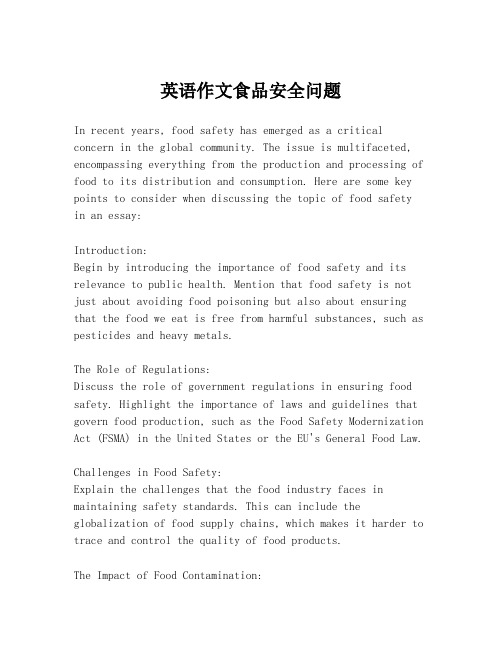
英语作文食品安全问题In recent years, food safety has emerged as a critical concern in the global community. The issue is multifaceted, encompassing everything from the production and processing of food to its distribution and consumption. Here are some key points to consider when discussing the topic of food safetyin an essay:Introduction:Begin by introducing the importance of food safety and its relevance to public health. Mention that food safety is not just about avoiding food poisoning but also about ensuring that the food we eat is free from harmful substances, such as pesticides and heavy metals.The Role of Regulations:Discuss the role of government regulations in ensuring food safety. Highlight the importance of laws and guidelines that govern food production, such as the Food Safety Modernization Act (FSMA) in the United States or the EU's General Food Law.Challenges in Food Safety:Explain the challenges that the food industry faces in maintaining safety standards. This can include the globalization of food supply chains, which makes it harder to trace and control the quality of food products.The Impact of Food Contamination:Detail the consequences of food contamination, such as foodborne illnesses, which can lead to serious health issues and even death. Use statistics to illustrate the scale of the problem.Preventive Measures:Outline the preventive measures that can be taken at various stages of the food supply chain. This can include proper hygiene practices, temperature control, and the use of food safety management systems like Hazard Analysis Critical Control Points (HACCP).Consumer Responsibility:Emphasize the role that consumers play in food safety. Discuss the importance of being informed about the food they eat, reading labels, and understanding food safety practices at home.Technological Advancements:Mention the role of technology in improving food safety, such as the use of blockchain for traceability, or the development of rapid testing methods for detecting contaminants.Conclusion:Conclude by summarizing the importance of a collective effort to ensure food safety. Stress the need for continuedvigilance from producers, regulators, and consumers alike to protect public health.Recommendations:End with recommendations for improving food safety. Thiscould include advocating for stricter regulations, promoting consumer education, or supporting research into new technologies that can enhance food safety.Remember to provide specific examples and case studies to support your points and to cite reliable sources to back up your arguments. Writing an essay on food safety requires a clear understanding of the topic and the ability to communicate complex ideas in a coherent and compelling manner.。
中国食物安全英文作文
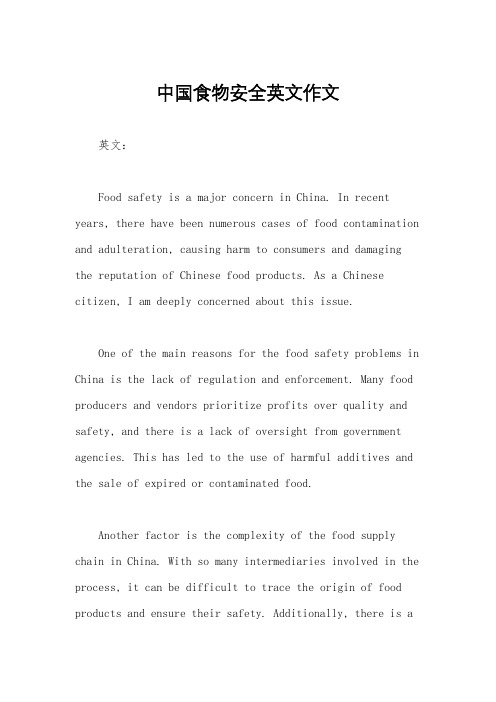
中国食物安全英文作文英文:Food safety is a major concern in China. In recent years, there have been numerous cases of food contamination and adulteration, causing harm to consumers and damaging the reputation of Chinese food products. As a Chinese citizen, I am deeply concerned about this issue.One of the main reasons for the food safety problems in China is the lack of regulation and enforcement. Many food producers and vendors prioritize profits over quality and safety, and there is a lack of oversight from government agencies. This has led to the use of harmful additives and the sale of expired or contaminated food.Another factor is the complexity of the food supply chain in China. With so many intermediaries involved in the process, it can be difficult to trace the origin of food products and ensure their safety. Additionally, there is alack of transparency and communication between different parts of the supply chain, making it difficult to identify and address issues.To improve food safety in China, there needs to be a concerted effort from all stakeholders. The governmentneeds to strengthen regulations and enforcement, and hold food producers and vendors accountable for their actions. Consumers also need to be more vigilant and demand higher quality and safer food products. Finally, the food industry needs to prioritize safety over profits and work to improve transparency and communication throughout the supply chain.中文:食品安全是中国的一个重要问题。
食品安全现状英语作文
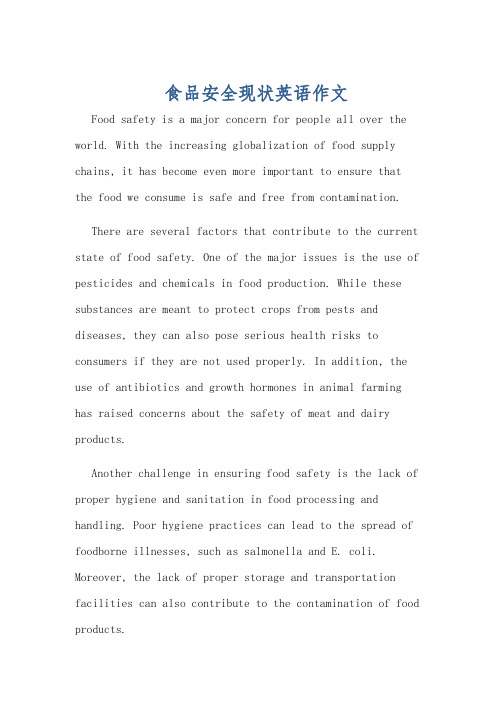
食品安全现状英语作文Food safety is a major concern for people all over the world. With the increasing globalization of food supply chains, it has become even more important to ensure that the food we consume is safe and free from contamination.There are several factors that contribute to the current state of food safety. One of the major issues is the use of pesticides and chemicals in food production. While these substances are meant to protect crops from pests and diseases, they can also pose serious health risks to consumers if they are not used properly. In addition, the use of antibiotics and growth hormones in animal farming has raised concerns about the safety of meat and dairy products.Another challenge in ensuring food safety is the lack of proper hygiene and sanitation in food processing and handling. Poor hygiene practices can lead to the spread of foodborne illnesses, such as salmonella and E. coli. Moreover, the lack of proper storage and transportation facilities can also contribute to the contamination of food products.In recent years, there have been several high-profile food safety incidents that have raised public awareness about the issue. For example, the 2008 Chinese milk scandal, where infant formula was found to be contaminated with melamine, resulted in the hospitalization of thousands of babies and several deaths. These incidents have led to increased scrutiny of food safety regulations and enforcement.In response to these challenges, governments and international organizations have been working to improve food safety standards and regulations. For example, theFood and Drug Administration (FDA) in the United States has implemented the Food Safety Modernization Act (FSMA) to prevent foodborne illnesses and improve the safety of imported foods. Similarly, the World Health Organization (WHO) has developed the Codex Alimentarius, a set of international food standards, guidelines, and codes of practice to ensure the safety, quality, and fairness of the international food trade.Despite these efforts, food safety remains a complex and ongoing issue. It requires the collaboration of governments,food producers, and consumers to ensure that the food supply is safe and free from contamination. Consumers can also play a role in promoting food safety by carefully selecting and handling food products, as well as by staying informed about food safety issues.食品安全是全球人们关注的一个重要问题。
食品安全英语作文20篇
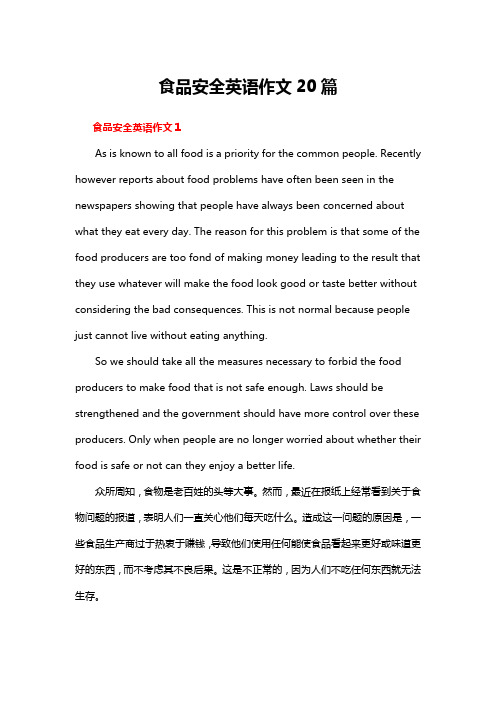
食品安全英语作文20篇食品安全英语作文1As is known to all food is a priority for the common people. Recently however reports about food problems have often been seen in the newspapers showing that people have always been concerned about what they eat every day. The reason for this problem is that some of the food producers are too fond of making money leading to the result that they use whatever will make the food look good or taste better without considering the bad consequences. This is not normal because people just cannot live without eating anything.So we should take all the measures necessary to forbid the food producers to make food that is not safe enough. Laws should be strengthened and the government should have more control over these producers. Only when people are no longer worried about whether their food is safe or not can they enjoy a better life.众所周知,食物是老百姓的头等大事。
关于食品安全问题的报告英语作文

Title: Report on Food Safety IssuesIntroduction:Food safety is a critical public health concern that has garnered significant attention in recent years. It refers to the handling, preparation, and storage of food in ways that prevent foodborne illness. Unfortunately, despite advancements in technology and regulations, food safety issues continue to persist, posing threats to consumer health worldwide. This report aims to discuss the current state of food safety, identify key challenges, and suggest potential solutions.Current State of Food Safety:The global food supply chain is complex, involving multiple stages from production to consumption. While many countries have implemented stringent food safetystandards and regulations, incidents of food contamination, adulteration, andmislabeling still occur. These issues can lead to outbreaks of foodborne diseases,which affect millions of people annually and result in substantial economic losses.Key Challenges:1.Globalization of Food Supply: The increased globalization of foodproduction and distribution has led to a more complex supply chain, making it difficult to ensure consistent safety standards across borders. 2.Emerging Contaminants: New and emerging contaminants, such asantibiotic-resistant bacteria and chemical contaminants from packaging materials, pose new challenges to food safety.3.Insufficient Infrastructure: In many developing countries, inadequateinfrastructure for food storage, transportation, and inspection contributes to food safety risks.4.Consumer Awareness: Lack of awareness about food safety practicesamong consumers can also contribute to the spread of foodborne illnesses, as improper handling and storage at home can lead to contamination.Potential Solutions:1.Strengthening Regulations and Standards: Governments shouldcollaborate to establish and enforce international food safety standards, ensuring consistency across the global supply chain.2.Investment in Infrastructure: Increasing investment in food safetyinfrastructure, particularly in developing countries, can help mitigate risks associated with inadequate storage and transportation.cation and Awareness: Enhancing public education on food safetypractices, including proper handling, storage, and preparation, can empower consumers to make safer food choices.4.Innovation in Food Technology: Encouraging innovation in foodtechnology, such as the development of smart packaging that monitors food freshness, can enhance food safety.5.Enhanced Surveillance and Response Systems: Establishing robustsurveillance systems for foodborne illnesses and rapid response mechanisms can effectively manage and control outbreaks.Conclusion:Food safety is a multifaceted issue requiring collaborative efforts from governments, industry players, and consumers. By addressing the key challenges outlined in this report and implementing the suggested solutions, we can make significant strides in enhancing food safety globally. It is imperative that we continue to prioritize food safety to protect public health and ensure a sustainable food supply chain for future generations.。
